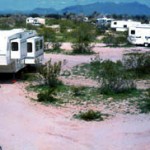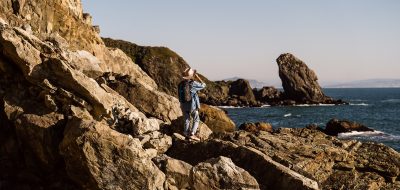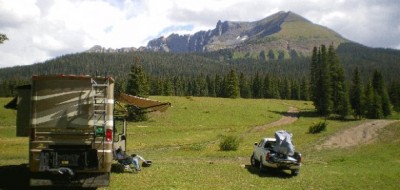 Many RVers would rather surf in a tsunami than camp in a desert wash, assuming both would yield the same results–tumbling tush over teacup in a roiling maelstrom flash flood of boulders, trees, and mangled RVs.
Many RVers would rather surf in a tsunami than camp in a desert wash, assuming both would yield the same results–tumbling tush over teacup in a roiling maelstrom flash flood of boulders, trees, and mangled RVs.
Many real-life stories circulate about hikers being washed away in flash floods, suddenly overtaken by a roaring freight train wall–of– water with no warning and clear skies overhead.
But these tales do not in themselves prove that every wash (“a dry creek bed or gulch that temporarily fills with water after a heavy rain, or seasonally” – Wikipedia) is unsafe to set up camp. To make an informed decision whether to camp in a wash, you need to study several factors about the wash. These include:
* Configuration and shape – Is the wash deep and narrow with steep sides constricting flow
* Width – Determines how far run-off can spread out, which also determines flow rate and depth
* Distance from head – The further from the head of the wash the more runoff will build up and the deeper the runoff will be
* Area of drainage – A wash that drains a large area of plateaus with many feeder washes will accumulate more runoff, producing deeper water, faster current, and more debris
* Evidence of previous flooding – Height of debris caught in limbs of shrubs and trees growing in the bottom of washes
* Season – Most flash floods occur in summer when heavy, short downpours produce a quick buildup of runoff
* Weather predictions – Keep up with weather predictions for the immediate and surrounding areas for at least three days ahead
 Washes to avoid would include those that are narrow with steep sides (photo left) that accumulate water like the end of a funnel. These are the most dangerous, especially if they are long and drain a large area with many feeder washes. These you would avoid completely in summer, and in winter if rain is predicted within five days in the immediate or surrounding areas. If you can find a wider wash, take it instead.
Washes to avoid would include those that are narrow with steep sides (photo left) that accumulate water like the end of a funnel. These are the most dangerous, especially if they are long and drain a large area with many feeder washes. These you would avoid completely in summer, and in winter if rain is predicted within five days in the immediate or surrounding areas. If you can find a wider wash, take it instead.
Those washes that would be safe to camp in would be wide, with no restrictions that would cause runoff to build up to anything over a couple inches in depth in heavy summer downpours. They would be short with few feeder washes to build up run-off, and have little evidence of debris caught up in tree branches and no evidence of uprooted trees or large boulders that had washed down.
The best time to camp in these washes would be when most of us are there, during the winter snowbird season, when rains are light and soaking, unlike the torrential downpours of the summer monsoons. Many dispersed desert camping areas are in washes that are safe, such as Craggy Wash (photo top) in Lake Havasu City.
But with climate change, El Nino effects, and the possibility of unusual weather patterns, it pays to keep abreast of the coming weather, and if the possibility of heavy rain is predicted, then it’s time to move to higher ground for a few days.
For more on boondocking check out my ebooks, BOONDOCKING: Finding the Perfect Campsite on America’s Public Lands, or Snowbird Guide to Camping and Boondocking in the Southwestern Deserts.





Guido 47
About 50 years ago, a Boy Scout summer camp site was set above a stream bed (just outside of Palo Duro Canyon) but was washed away by one of those summer Texas storms. About 10-12″ of rain in one night, and pretty much all the tents and sleeping bags gone. At least all the boys came home. Cold, dark, wet, and all over really fast. I think staying above the washes is a good idea, and the comments about clear skies overhead are right on. That water can move a long way and get to you really fast.
I’d avoid being down in the wash. At Antelope Canyon North (AZ), in one of the slot canyons (the RV will not fit in there), there was a tree trunk about the size of a telephone pole stuck in the rock canyon walls about 20 feet up in the air. Always kinda wondered how it got there?
Al Gonzalez
My fridge wen out, can I install just a 115V unit
Niblick
Hmmm. No ‘trace camping’?!? Surely there are some GOOD reasons out there to camp in a temporarily-only dry riverbed that could flood without notice. Yes, I guess I did it as a neophyte camper in the old days…unintentionally.
Seems to me now that that I’m a bit grayer and wiser (I hope), that choosing higher ground in the first place affords several advantages; a better view around, better breezes, fewer scavenging rodents and reptiles around camp where I eat and sleep, and of course, safe sleeping away from sudden and deadly flash floods. I’d like to see some more observations on advantages of camping on higher safer ground versus camping in the all too-exciting flash flood zone. Heh, heh.
Ed
The best reason to camp in a wash is no trace camping. The next storm will wash away the tire tracks after you’ve already picked up everything else. We camp in the same wash every year and every year it looks like we were the first people there.